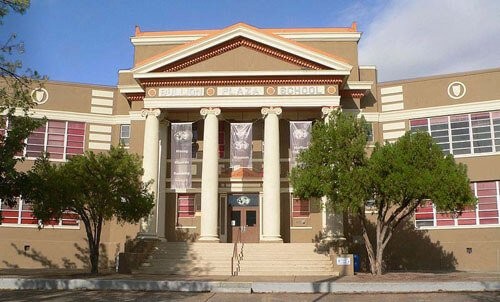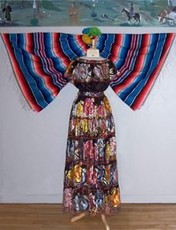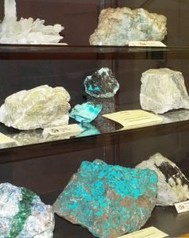Bullion Plaza Cultural Center & Museum
Introduction
Text-to-speech Audio
Images
Exterior of the Bullion Plaza School while it was in use.

Bullion Plaza as it appears today.

A traditional dress on display in the Mexican Cultural Exhibit.

Some of the Minerals on display from the local area.

Backstory and Context
Text-to-speech Audio
The Bullion Plaza Cultural Center & Museum resides in what used to be the Bullion Plaza School. The school was built in 1923 to solve the overflow of students in the local school district. The school was also built to supply an improved school for Mexican-American students. Dubbed a “Mexican school” at the time, it was mainly used for the segregation of Mexican American students.
Claims for segregation of Mexican-American students were of having a language deficit and low dropout rates. These reasons came from biases of the time and a seen need to “Americanize” Mexican-American students. These schools were of lower quality to their Anglo counterparts and taught more vocational courses than the standard academic courses. This practice persisted throughout the first half of the twentieth-century eventually diminishing around the 1950s. It was around this time desegregation of Mexican-American students came about aligning with the desegregation of African-American students.
The Bullion Plaza School continued to be used past times of segregation till 1994. The school closed due to worries over the building's structure. Throughout this time the building has maintained its Neo-Classical Revival style. The style was implemented by the architectural firm Trost & Trost, displaying a style that was popular in the United States at the turn of the century with the school being a late and modest example. The Building was listed on the National Register of Historic Places in 2000 for the building’s implementation of this style.
Today the building is in use for the Bullion Plaza Cultural Center & Museum. The museum strives to display the diverse history of the local area and the artifacts found there. Examples of these include displays of local minerals and fossils and the Slavic and Native American history of the area. One notable display is the Mexican Culture Exhibit. Residing in the school building’s library, it showcases culture and history from the Mexican population of the area, while also detailing the school’s history. Within this exhibit, murals from teachers and students of the 20s are included, which have recently been restored.
Sources
2. Mexican Cultural Exhibit. Bullion Plaza Cultural Center & Museum. Accessed April 16, 2019. https://bullionplazamuseum.org/permanent-exhibits/mexican-cultural-exhibit/.
3. National Register of Historic Places Registration Form. National Park Service. Accessed April 16, 2019. https://www.nps.gov/nr/feature/hispanic/2008/00001591-text.pdf.
4. Permanent Exhibits. Bullion Plaza Cultural Center & Museum. . Accessed April 16, 2019. https://bullionplazamuseum.org/permanent-exhibits/.
5. Photo of Bullion Plaza Cultural Center & Museum. Bullion Plaza Cultural Center & Museum. Accessed April 22, 2019. https://bullionplazamuseum.org/bullion-plaza-school-sky/.
6. Photo of Bullion Plaza School. National Register of Historic Places. Accessed April 21, 2019. http://www.nps.gov/nr/feature/hispanic/2008/bullion_plaza_school.htm.
7. Photo of Minerals. Bullion Plaza Cultural Center & Museum. Accessed April 22, 2019. https://bullionplazamuseum.org/permanent-exhibits/minerals-geology/.
8. Photo of Traditional Dress. Bullion Plaza Cultural Center & Museum. Accessed April 22, 2019. https://bullionplazamuseum.org/permanent-exhibits/mexican-cultural-exhibit/.
